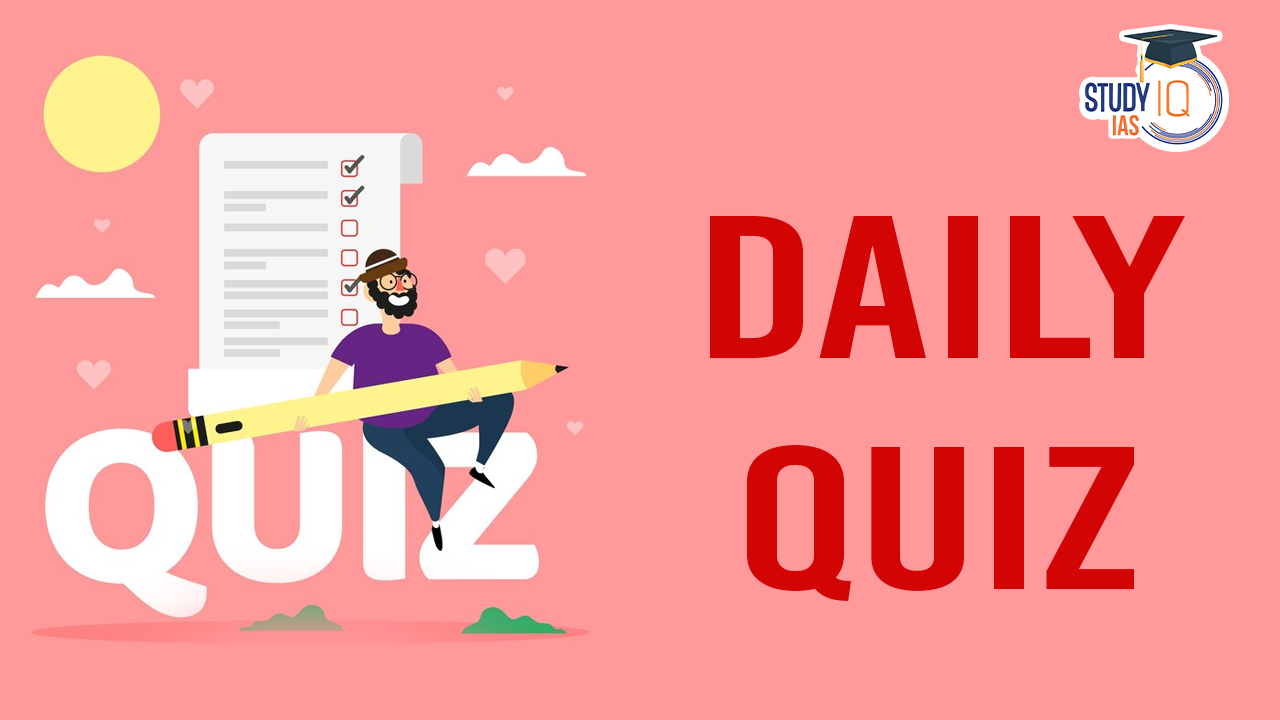Daily Quiz 07 July 2025
Quiz-summary
0 of 5 questions completed
Questions:
- 1
- 2
- 3
- 4
- 5
Information
- Click on – ‘Start Quiz’ button
- Solve Questions
- Click on ‘Next’ button
- Click on ‘Finish Quiz’ button
- Now click on ‘View Questions’ button – here you will see solutions and links.
- The test contains a total of 5 questions.
- Click on the most appropriate option to mark it as your answer.
- You will be awarded Two marks for each correct answer.
- You can change your answer by clicking on some other option.
- A Number list of all questions appears at the top side of the screen.
- You can access the questions in any order by clicking on the question number given on the number list.
- You can use rough sheets while taking the test.
- Do not use calculators, log tables, dictionaries, or any other printed/online reference material during the test.
- Do not click the button “Finish Quiz” before completing the test. A test once submitted cannot be resumed.
You have already completed the quiz before. Hence you can not start it again.
Quiz is loading...
You must sign in or sign up to start the quiz.
You have to finish following quiz, to start this quiz:
- 1
- 2
- 3
- 4
- 5
- Answered
- Review
-
Question 1 of 5
1. Question
1 pointsWhich of the following statements are correct regarding two prominent U.S. installations—Al-Udeid and Ain al-Assad?
1. Al-Udeid Air Base in Qatar hosts the forward headquarters of U.S. Central Command (CENTCOM).
2. Ain al-Assad Air Base is located within Iranian territory close to the city of Kermanshah.
3. Al-Udeid lies roughly 190 km across the Persian Gulf from Iran’s shoreline.
4. Ain al-Assad has been repeatedly used by U.S. forces coordinating operations against the Islamic State (ISIS).
Select the correct answer using the code below:Correct
Answer: (b)
Explanation
Statement 1 is Correct.Al-Udeid, southwest of Doha, houses CENTCOM’s air component (USAFCENT) and Combined Air Operations Center, making it the hub for U.S. air tasking orders from Egypt to Afghanistan.
Statement 2 is Incorrect. Ain al-Assad is in western Iraq’s Anbar Province, not inside Iran. The confusion sometimes arises because Iranian missiles have targeted it.
Statement 3 is Correct. Map distance from Al-Udeid to Iran’s Bushehr coastline is about 190 km, placing strategic U.S. air power literally across the Gulf from Iranian missile batteries.
Statement 4 is Correct. The base sheltered U.S. Marines in Operation Inherent Resolve; it endured ballistic-missile strikes in January 2020 and again in 2025, underscoring its frontline role.
Incorrect
Answer: (b)
Explanation
Statement 1 is Correct.Al-Udeid, southwest of Doha, houses CENTCOM’s air component (USAFCENT) and Combined Air Operations Center, making it the hub for U.S. air tasking orders from Egypt to Afghanistan.
Statement 2 is Incorrect. Ain al-Assad is in western Iraq’s Anbar Province, not inside Iran. The confusion sometimes arises because Iranian missiles have targeted it.
Statement 3 is Correct. Map distance from Al-Udeid to Iran’s Bushehr coastline is about 190 km, placing strategic U.S. air power literally across the Gulf from Iranian missile batteries.
Statement 4 is Correct. The base sheltered U.S. Marines in Operation Inherent Resolve; it endured ballistic-missile strikes in January 2020 and again in 2025, underscoring its frontline role.
-
Question 2 of 5
2. Question
1 pointsConsider the following statements:
Statement I:
The Programme of Cultural Cooperation (POCC) between India and the U.K. aims to strengthen bilateral ties through exhibitions, performances, and cultural property preservation.Statement II:
The POCC promotes integration of digital technologies and sustainable practices in India-U.K. cultural partnerships.Statement III:
The POCC restricts cultural collaboration to government bodies and excludes corporate participation in heritage preservation.Which one of the following is correct in respect of the above statements?
Correct
Answer: (d)
Explanation:
- Statement I is correct: The POCC signed in May 2024 sets a formal roadmap to deepen India–U.K. cultural relations, particularly in areas such as exhibitions, performing arts, and heritage conservation.
- Statement II is also correct: One of the five focus areas of the POCC is the use of digital technologies like AI and AR/VR in cultural dissemination, along with a strong emphasis on sustainability (e.g., eco-friendly cultural practices, supporting artisanship).
- Statement III is incorrect: The POCC does not exclude corporate participation. In fact, it encourages it — as seen with Royal Enfield and UNESCO’s Himalayan Knot project, which preserves textile traditions and supports artisans. This shows active private-sector involvement.
- How Statement II explains Statement I:
The integration of technology and sustainability directly supports and enhances the objectives mentioned in Statement I (strengthening exhibitions, performances, and preservation).
Thus, Statement II supports Statement I, while Statement III contradicts actual facts.
Hence, option (d) is correct.Incorrect
Answer: (d)
Explanation:
- Statement I is correct: The POCC signed in May 2024 sets a formal roadmap to deepen India–U.K. cultural relations, particularly in areas such as exhibitions, performing arts, and heritage conservation.
- Statement II is also correct: One of the five focus areas of the POCC is the use of digital technologies like AI and AR/VR in cultural dissemination, along with a strong emphasis on sustainability (e.g., eco-friendly cultural practices, supporting artisanship).
- Statement III is incorrect: The POCC does not exclude corporate participation. In fact, it encourages it — as seen with Royal Enfield and UNESCO’s Himalayan Knot project, which preserves textile traditions and supports artisans. This shows active private-sector involvement.
- How Statement II explains Statement I:
The integration of technology and sustainability directly supports and enhances the objectives mentioned in Statement I (strengthening exhibitions, performances, and preservation).
Thus, Statement II supports Statement I, while Statement III contradicts actual facts.
Hence, option (d) is correct. -
Question 3 of 5
3. Question
1 pointsConsider the following statement regarding India’s Kishanganga and Ratle projects:
- Ratle is on the Chenab River in Kishtwar district, while Kishanganga diverts the Neelum/Kishanganga River in Bandipora district.
- Pakistan’s objections prompted India in 2025 to suspend certain Indus Waters Treaty obligations and to request the World Bank to pause parallel dispute-resolution tracks.
- A 2013 Permanent Court of Arbitration award permitted Kishanganga’s diversion provided India maintained a minimum environmental flow of 9 m³/s downstream of the dam.
- Both projects utilise run-of-river designs but differ in installed capacities: Kishanganga ~330 MW and Ratle ~850 MW.
How many of the above statements are correct?
Correct
Answer: (d)
Explanation
Statement 1 is Correct.Ratle-Chenab, Kishtwar; Kishanganga-tributary of the Jhelum in North Kashmir (called Neelum in Pakistan).
Statement 2 is Correct. Citing “procedural impasse,” India invoked Article XII notification in Jan 2025, froze treaty-mandated data exchanges and asked the World Bank to halt both the Court of Arbitration and Neutral Expert tracks running in parallel.
Statement 3 is Correct. The PCA’s partial award fixed 9 cumecs as the “environmental minimum flow,” aiming to safeguard downstream fisheries and riparian livelihoods in Pakistan-administered Kashmir.
Statement 4 is Correct. Both plants are run-of-river-no large seasonal storage-yet Ratle’s five-unit design totals ~850 MW, more than double Kishanganga’s three-unit 330 MW capacity.
Incorrect
Answer: (d)
Explanation
Statement 1 is Correct.Ratle-Chenab, Kishtwar; Kishanganga-tributary of the Jhelum in North Kashmir (called Neelum in Pakistan).
Statement 2 is Correct. Citing “procedural impasse,” India invoked Article XII notification in Jan 2025, froze treaty-mandated data exchanges and asked the World Bank to halt both the Court of Arbitration and Neutral Expert tracks running in parallel.
Statement 3 is Correct. The PCA’s partial award fixed 9 cumecs as the “environmental minimum flow,” aiming to safeguard downstream fisheries and riparian livelihoods in Pakistan-administered Kashmir.
Statement 4 is Correct. Both plants are run-of-river-no large seasonal storage-yet Ratle’s five-unit design totals ~850 MW, more than double Kishanganga’s three-unit 330 MW capacity.
-
Question 4 of 5
4. Question
1 pointsConsider the following statements:
Statement I:
South Asia remains one of the least economically integrated regions in the world, despite having multiple regional trade agreements and forums.Statement II:
Intraregional trade forms only 5-7% of South Asia’s total trade and the region faces high trade costs due to political tensions and inefficient implementation of trade agreements.Statement III:
Over 85% of South Asia’s trade potential remains unrealized, especially in countries like Bangladesh, Maldives, and Pakistan.Which one of the following is correct in respect of the above statements?
Correct
Answer: (a)
Explanation:
- Statement I is correct – Despite SAARC and SAFTA, South Asia remains weakly integrated with low intra-regional trade.
- Statement II is correct – Intra-regional trade is only 5–7% of the region’s trade, and barriers like high tariffs, weak implementation of SAFTA, and persistent border tensions raise trade costs. This directly explains the lack of integration.
- Statement III is correct – Countries like Bangladesh (93% untapped), Maldives (88%), and Pakistan (86%) have huge unrealized potential, reinforcing the underutilization of regional opportunities. This also supports Statement I.
Both Statement II and III explain why South Asia is poorly integrated economically.
So, option (a) is correct.Incorrect
Answer: (a)
Explanation:
- Statement I is correct – Despite SAARC and SAFTA, South Asia remains weakly integrated with low intra-regional trade.
- Statement II is correct – Intra-regional trade is only 5–7% of the region’s trade, and barriers like high tariffs, weak implementation of SAFTA, and persistent border tensions raise trade costs. This directly explains the lack of integration.
- Statement III is correct – Countries like Bangladesh (93% untapped), Maldives (88%), and Pakistan (86%) have huge unrealized potential, reinforcing the underutilization of regional opportunities. This also supports Statement I.
Both Statement II and III explain why South Asia is poorly integrated economically.
So, option (a) is correct. -
Question 5 of 5
5. Question
1 pointsConsider the following statements:
Statement I:
The recent decline in inflation in India is being misinterpreted as a sign of overall economic health, despite accompanying rises in unemployment and slowing GDP growth.Statement II:
The drop in inflation in May 2025 was largely driven by improved agricultural output and lower food prices, not by any significant monetary policy action by the RBI.Statement III:
Rising agricultural productivity alone is sufficient to solve India’s broader macroeconomic challenges such as unemployment and weak industrial growth.Which one of the following is correct in respect of the above statements?
Correct
Answer: (c)
Explanation:
- Statement I is correct – Inflation dropped to 2.8%, but unemployment rose (from 5.1% to 5.8%) and GDP growth fell (from 9.2% to 6.5%). This suggests inflation reduction is not the only—or even the best—measure of economic well-being.
- Statement II is correct – RBI had kept the repo rate unchanged since June 2022. The key factor in inflation reduction was the food supply boost from agriculture, not monetary tightening. This helps explain the misinterpretation in Statement I.
Statement III is incorrect – While agriculture helped lower food prices, it cannot alone address unemployment or boost industrial and services sector growth. Structural issues in job creation and demand must also be tackled.
Incorrect
Answer: (c)
Explanation:
- Statement I is correct – Inflation dropped to 2.8%, but unemployment rose (from 5.1% to 5.8%) and GDP growth fell (from 9.2% to 6.5%). This suggests inflation reduction is not the only—or even the best—measure of economic well-being.
- Statement II is correct – RBI had kept the repo rate unchanged since June 2022. The key factor in inflation reduction was the food supply boost from agriculture, not monetary tightening. This helps explain the misinterpretation in Statement I.
Statement III is incorrect – While agriculture helped lower food prices, it cannot alone address unemployment or boost industrial and services sector growth. Structural issues in job creation and demand must also be tackled.
Results
0 of 5 questions answered correctly
Your time:
Time has elapsed
You have reached 0 of 0 points, (0)
| Average score |
|
| Your score |
|
Categories
- Not categorized 0%
| Pos. | Name | Entered on | Points | Result |
|---|---|---|---|---|
| Table is loading | ||||
| No data available | ||||
Sharing is caring!


 Daily Quiz 18 September 2025
Daily Quiz 18 September 2025

























